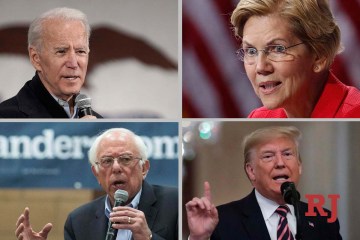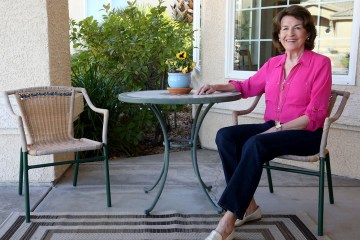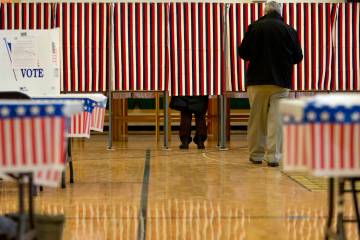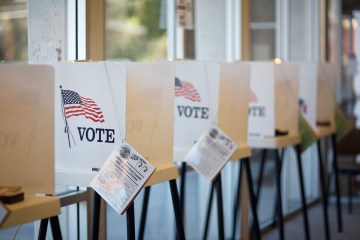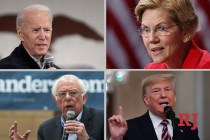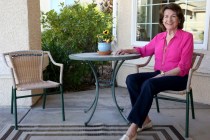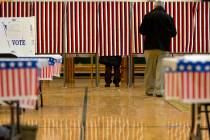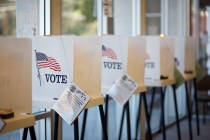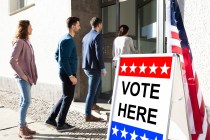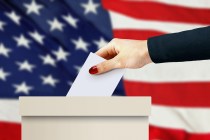Are you an unaffiliated voter? Here’s how political consultants are targeting you
As more Nevadans choose to register as nonpartisan, the relatively small group of veteran campaign consultants guiding most of the local and statewide candidates faces an interesting question: How to appeal to the diverse range of unaffiliated voters while also keeping base voters motivated?
In interviews with the Review-Journal, a handful of these key decision-makers from both parties offered a variety of responses.
Above all, they agreed, there needs to be a strong candidate. But after that? It depends.
Some believe diversifying their campaign message may be the answer, that tackling practical issues while distancing the candidate from national party lines may appeal to moderate voters.
Others point to the dormant partisan nature of many nonpartisan voters, saying cutting-edge data analysis can be tuned toward turning out those voters who may inherently agree with a candidate or discourage the supporters of a rival from voting.
Whatever the preferred approach, one national expert with decades of experience organizing independent voters suggests those who make their living in the two-party system should understand that a reckoning is underway. Thousands of voters are choosing not to register with a major party, even though the system rewards membership through closed primary systems.
She says efforts to identify and motivate nonpartisans take away from a bigger question: Why are there so many nonpartisans in the first place?
An independent’s view
Jackie Salit is the president and co-founder of Independent Voting. Since 1994, it has existed as a third party, a federation of state parties and, most recently, as an advocacy group for unaffiliated voters. Salit has also worked on campaigns herself, including 2020 Democratic presidential candidate Michael Bloomberg’s independent bids for New York mayor.
This spike in independents should be taken by the parties as a sign that the public is growing weary of the parties’ outsized influence and power in American politics, Salit said, as well as a general rebuke of the increased partisanship by both sides.
“People are more and more making the link between the hyper-partisanship of politics and the dysfunction of government,” Salit said. “That is very, very troubling to people. And the more people who make that link, the more the parties are being held accountable.”
She continued: “The parties have usurped from the voters a level of governmental power for themselves that the framers of the Constitution did not plan for. Political parties are not mentioned in the Constitution.”
George Washington famously denounced a two-party system in his farewell presidential address, Salit added.
During the last 25 years, Salit has seen a rise from 32-34 percent of voters self-identifying as independents to as high as 45 percent — nearly half of the electorate. More than half of millennials identify as independent, for example.
She uses surveys from Gallup and the Pew Research Center, she says, because voter registration can be misleading. States don’t have a uniform way of identifying independent voters. Some are “no-party preference,” such as California. Some are “nonpartisan,” such as Nevada. (Our state also features an active third party known as the “Independent American Party,” which some voters may have selected by mistake, thinking they were registering as nonpartisan.)
And in other states, such as Virginia, voters register without a public party affiliation.
Salit also suspects some nonpartisans declare a party affiliation so they can participate in closed primaries, which her organization has worked to abolish.
Persuasion is dying
Rory McShane started his namesake Las Vegas consultancy two years ago, after nearly a decade working on Republican campaigns as an employee of larger firms.
For years, McShane said, campaigns have fumbled by using complex messaging. He pointed to the “simple storyboard” of recent presidential elections as examples of proper messaging.
“You have a hero, you have a villain and you have a problem,” McShane said.
In 2004, the problem was the world is unsafe. The villain was Osama bin Laden, and the hero is “cowboy George W. Bush.”
In 2008, Washington was stuck in the mud with political insiders. The Bush family and Washington establishment were the enemy, and Barack Obama emerged as the hero, promising hope and change.
This storyboard, McShane said, is fanned out a little differently for nonpartisans, but it is the same simple narrative.
President Donald Trump won over independent voters in 2016 by portraying “the swamp” as the problem, former Secretary of State Hillary Clinton as its spokesperson and villain, and promising to “kick it all over” to solve the problem.
Beyond a simple core message, tailoring other messages to nonpartisans can often fail to bear fruit, McShane said, because the ideological spectrum of nonpartisans is too large.
He believes data is the better approach.
Consumer data can form models based on nonpartisans who are easily identified as conservatives and add them, in terms of predicting an election, into the Republican base — once the sole focus of Republican campaigns, McShane said.
“If somebody is a registered nonpartisan, and they subscribe to Field and Stream magazine, and they drive a Ford F-150, and they’re a white male who carries a platinum American Express, we need to make sure that person gets to the polls, because they’re probably voting Republican,” McShane said.
Trying to persuade voters to match your candidate’s viewpoint is a dying strategy, McShane said. In the ’80s and ’90s, an entire campaign would be centered on persuasion with only about three days set aside for getting out the vote.
“The amount of money that Republicans have poured down the drain trying to convince moderate, suburban voters is absolutely disgusting,” McShane said.
Now, McShane said the campaign’s time should break down as: 40 percent registering and mobilizing base and like-minded nonpartisans, 40 percent getting those folks to the polls and 20 percent trying to persuade those on the fence or on the other side.
Changing times
After about 30 years working on campaigns, Michael Sullivan now focuses more on lobbying with the Ferraro Group. Although he did work as an unpaid adviser on Gov. Steve Sisolak’s campaign, he mostly stays out of the on-the-ground work.
But Sullivan said he has noticed some significant changes in recent years as nonpartisan registration has surged.
“When I was doing campaigns, you didn’t really care about nonpartisans,” Sullivan said.
Sullivan said nonpartisans were seen as angry voters who were choosing not to participate in the system. Marketing to them was difficult because no one knew what they wanted.
“We’d try to suppress (Republican) voters and get ours out,” Sullivan said. “That’s it.”
Campaigns were focused on media, messaging and polling. Each are still important, especially in local campaigns, but now campaigns have entire teams dedicated to data work, trends and identifying like-minded voters.
Sullivan said the data has allowed for significant voter suppression efforts on the national side, citing the 2016 election as an example.
Some Democratic voters may have preferred Sanders, for example, but they still identified more with Clinton than Trump. They were encouraged to stay home or simply skip over the presidential race on their ballots.
Sullivan expects this will only continue, as big-money players have looked to spend significantly in order to create doubt in an opponent’s supporters.
It’s the issues
Steve Forsythe got his start in Nevada politics by helping a friend run successfully for the state Assembly in 1982. His candidate list includes former Sen. John Ensign and former Gov. Kenny Guinn, but he prefers local city and county races these days as the managing team member of First Tuesday.
Given that local races are nonpartisan by rule, Forsythe takes a different approach to representing mostly conservative candidates.
Forsythe says a strong ground game — knocking on doors and talking to as many people as possible — will identify key issues in a given local race, which can then be used as the basis for forming messages rather than typical party lines.
About 15 percent of Republicans are hardline conservatives, Forsythe said, while about 15 percent think more like a Democrat might. Races are won and lost in that middle 70 percent. And he believes most of the defections from either party to nonpartisan also come from that middle section, meaning most nonpartisans are somewhat moderate.
All voters, he said, are fatigued by the partisan national dialogue taking place between the two parties.
“Voters care about local issues,” Forsythe said. “There’s no sidewalk across the street in my neighborhood. My neighbor has a bunch of old cars on his lawn.”
Contrary to McShane, Forsythe still believes in concentrating on converting that “middle 70 percent” of voters.
“I need to put all of my resources into that group in the middle to convince them my candidate is the best man or woman for them,” Forsythe said.
However, he agreed that identifying supporters through data is important, as it helps cash-strapped local campaigns make better use of their spending.
Forsythe believes catering a conservative’s message to nonpartisans is key, as Republicans can use the nonpartisan bloc — which is almost the size of the Republican bloc in many areas — to overcome a Democratic registration advantage.
Young voters
Kami Dempsey, president of Accretive Consulting, has spent about 25 years splitting time between campaign work, mostly on the Democratic side, and lobbying. (Dempsey lobbies the Nevada Legislature on behalf of the Review-Journal, among other clients).
For years, she said, the parties signified two clear, opposing sides in the policy debate. But the proliferation of nonpartisans means fewer voters, particularly younger ones, identify in such clear ways. Many jump across the spectrum on social or fiscal issues, and some prioritize aligning with these issues over choosing a candidate from a specific party.
Creating a message that can appeal to nonpartisans and using data to identify those favorable to your candidate are equally important, Dempsey said. Both lend something to the all-important field operations — reaching voters wherever they may be and convincing them to turn out.
“It is a numbers game, but at the same time, you have to have the messages and your candidate has to be able to convey that clearly and concisely,” she said.
Data is particularly key in Nevada due to deep regional differences, Dempsey said. The south is predominantly Democrat, and the north is not. But even the Democrats in the north look very different than their counterparts in the south. Identifying the issues that move voters where they live — literally and figuratively — is important.
Dempsey believes party ranks will flatline in the future while nonpartisan registration will continue to rise unless the parties redefine themselves in the more forward-thinking ways young voters demand.
A cautionary tale
Salit, of Independent Voting, says the parties should take the growing nonpartisan momentum and disillusionment into account when campaigning. Simply identifying which independents may lean a certain way and catering to those — while sometimes even trying to discourage those who lean the opposite way — is “short-sighted.”
“If all you’re doing is trolling for votes, then you relate the entire voting public as a yes, no or maybe. And you depress your no voters and get your yes voters,” she said.
“But if you’re trying to lay the foundation and propel a new political force into the future, then how to appeal to independents becomes a more significant question.”
Salit said academics and pollsters pay too much attention to nonpartisan voters’ political leanings, rather than asking why, in a system that rewards party membership through closed primaries and other means, are so many people opting out?
“The whole notion of how to appeal to independent voters is becoming more important,” she said.
Our political team is looking for active, registered nonpartisan voters interested in sharing their opinions on the 2020 elections. If you would like to participate in upcoming panels, please email us at themiddle@reviewjournal.com or contact us using the form below:
Contact Rory Appleton at rappleton@reviewjournal.com or 702-383-0276. Follow @RoryDoesPhonics on Twitter.
"The Middle" is a yearlong look by the Review-Journal at nonpartisan and independent voters, who are growing in number across the country. These voters — who have chosen not to affiliate with any major or minor political party — will play a pivotal role in deciding the outcome of the 2020 race for president.



